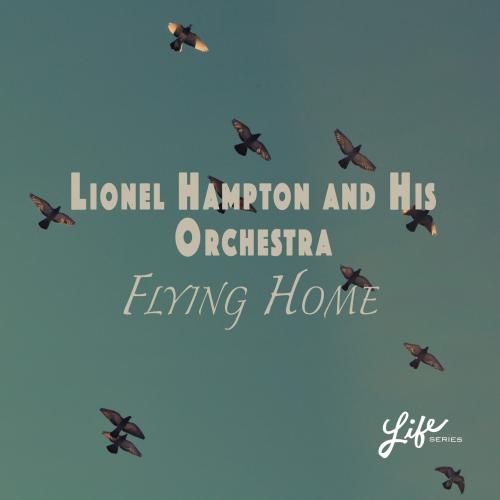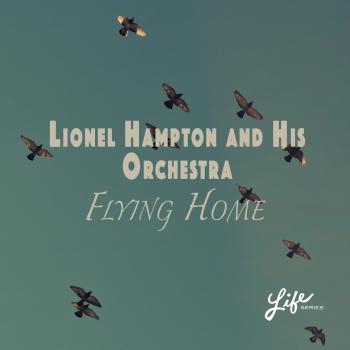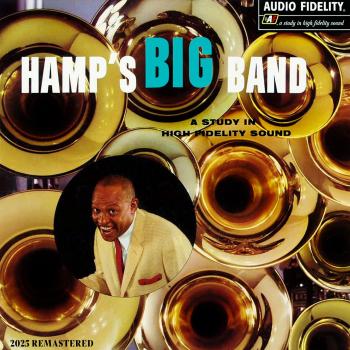
Flying Home (Remastered) Lionel Hampton and His Orchestra
Album Info
Album Veröffentlichung:
1965
HRA-Veröffentlichung:
22.01.2020
Das Album enthält Albumcover
- 1 Just for You 03:10
- 2 Southern Echoes 02:38
- 3 My Wish 02:53
- 4 Nola 03:11
- 5 Royal Family 03:03
- 6 I Can't Believe That You're in Love with Me 03:12
- 7 Blues in the News 03:07
- 8 Exactly Like You 03:00
- 9 Now I Know 03:06
- 10 Half a Loaf Is Better Than None 02:55
- 11 Flying Home 03:10
- 12 In the Bag 03:21
- 13 Loose Wig 03:04
- 14 Chop-Chop 03:09
- 15 Flying Home, No. 2 03:05
- 16 Boogie Woogie (Hamp's Boogie Woogie) 03:15
- 17 Million Dollar Smile 03:02
- 18 The Lamplighter 03:03
- 19 Overtime 02:55
- 20 Tempo's Boogie 03:05
Info zu Flying Home (Remastered)
By the time Lionel Hampton started playing the vibraphone in the late 1920s he already had the reputation as being one of the fastest drummers in the world. He became famous for his appearances with the Benny Goodman Quartet, one of the most important bands of the swing-era and went on to become among the great names in jazz history.
"Flying Home" is a jazz and jump blues composition written by Benny Goodman and Lionel Hampton with lyrics by Sid Robin. It was reportedly developed around a tune Hampton whistled as he nervously waited for his first flight on an aircraft.
It was first recorded by the Benny Goodman Sextet on November 6, 1939, featuring solos by Hampton and Charlie Christian. Several other groups recorded the tune. In 1942, Lionel Hampton and His Orchestra recorded the song with a tenor saxophone solo by nineteen-year-old Illinois Jacquet. The song became the climax for live shows, and Jacquet was exhausted from having to play it every night. Singer Chris Connor recorded the song for Atlantic Records and released it as a single in 1959. Harry James recorded a version in 1965 on his album New Versions of Down Beat Favorites (MGM).
Lionel Hampton and His Orchestra
Digitally remastered
Lionel Hampton and His Orchestra
One of the most high-profile bands of its day, Lionel Hampton’s orchestra broke new musical ground and helped pioneer rhythm and blues (R&B). Hampton founded his big band in 1940 after leaving Benny Goodman’s band. Though Hampton’s existing stardom gave the band immediate good favor in the jazz world, the band’s prominence reached new heights with their 1942 recording of “Flying Home.” The recording featured an electrifying tenor solo from Illinois Jacquet, and many consider the record one of the first R&B recordings. “Flying Home” became an anthem for Hampton and Jacquet, the both would continue performing it throughout their careers. R&B also became a more central part of the Hampton band’s sound, and later iterations of the group included figures like Charles Mingus, Wes Montgomery, and Johnny Griffin.
Lionel Hampton
Featuring outstanding sidemen and soloists, as well as his own swinging vibe playing, Lionel Hampton's bands during the 1940s and 1950s were among the most popular and most exciting in jazz. Hampton was raised in the Midwest, primarily in Kenosha, Wisconsin, where he received his first musical training. His career began behind the drums, taking his first music job in a newsboys' band sponsored by the Chicago Defender.
In 1928, Hampton moved west to California, landing first in the Paul Howard Orchestra, later working with bandleaders Eddie Barefield and Les Hite. In 1929 he took up the vibraphone with the Hite band, which at the time was led by Louis Armstrong, becoming a pioneering figure in the use of vibes in a jazz band.
Hampton made his recorded debut on an Armstrong version of "Memories of You" in 1930. By 1934, Hampton had become leader of his own band, performing at Sebastian's Cotton Club in Los Angeles. Benny Goodman saw Hampton perform at one of his gigs and recruited him to augment his trio, with Teddy Wilson and Gene Krupa, for a 1936 recording date. Hampton remained in Goodman's band through 1940, occasionally replacing Krupa on the drums. Hampton became well known with the Goodman band, and started his own big band, achieving his biggest recorded hit with "Flying Home" in May 1942, driven by Illinois Jacquet's unforgettable tenor saxophone solo.
Hampton's popular big band boasted such potent musicians as Dexter Gordon, Clifford Brown, Fats Navarro, Johnny Griffin, Charles Mingus, Art Farmer, Clark Terry, Cat Anderson, Wes Montgomery, and singers Dinah Washington, Joe Williams, Betty Carter, and Aretha Franklin. He toured the globe and continued to nurture young talent, often providing some of the earliest band experiences to musicians who went on to become leaders in their own right. His band became the longest established orchestra in jazz history.
Lionel Hampton received numerous awards of merit, including several honorary doctoral degrees, the National Medal of Arts, and the Kennedy Center Honors. His diligent work with the jazz festival at the University of Idaho in Moscow led to it being renamed the Lionel Hampton International Jazz Festival in 1985. The university's music department shortly followed suit and became the Lionel Hampton School of Music. Winner of numerous polls, Hampton had been an honored soloist into the 1990s, performing in numerous festivals as part of all-star assemblages. In 2001, he donated his vibraphone to the Smithsonian Institution.
Dieses Album enthält kein Booklet











